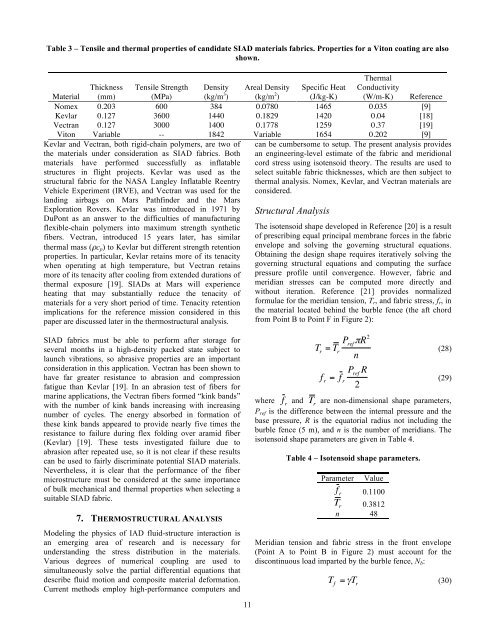Thermal, Structural, and Inflation Modeling of an Isotensoid ...
Thermal, Structural, and Inflation Modeling of an Isotensoid ...
Thermal, Structural, and Inflation Modeling of an Isotensoid ...
You also want an ePaper? Increase the reach of your titles
YUMPU automatically turns print PDFs into web optimized ePapers that Google loves.
Table 3 – Tensile <strong><strong>an</strong>d</strong> thermal properties <strong>of</strong> c<strong><strong>an</strong>d</strong>idate SIAD materials fabrics. Properties for a Viton coating are also<br />
shown.<br />
Material<br />
Thickness<br />
(mm)<br />
Tensile Strength<br />
(MPa)<br />
Density<br />
(kg/m 3 )<br />
Areal Density<br />
(kg/m 2 )<br />
Specific Heat<br />
(J/kg-K)<br />
<strong>Thermal</strong><br />
Conductivity<br />
(W/m-K) Reference<br />
Nomex 0.203 600 384 0.0780 1465 0.035 [9]<br />
Kevlar 0.127 3600 1440 0.1829 1420 0.04 [18]<br />
Vectr<strong>an</strong> 0.127 3000 1400 0.1778 1259 0.37 [19]<br />
Viton Variable -- 1842 Variable 1654 0.202 [9]<br />
Kevlar <strong><strong>an</strong>d</strong> Vectr<strong>an</strong>, both rigid-chain polymers, are two <strong>of</strong><br />
the materials under consideration as SIAD fabrics. Both<br />
materials have performed successfully as inflatable<br />
structures in flight projects. Kevlar was used as the<br />
structural fabric for the NASA L<strong>an</strong>gley Inflatable Reentry<br />
Vehicle Experiment (IRVE), <strong><strong>an</strong>d</strong> Vectr<strong>an</strong> was used for the<br />
l<strong><strong>an</strong>d</strong>ing airbags on Mars Pathfinder <strong><strong>an</strong>d</strong> the Mars<br />
Exploration Rovers. Kevlar was introduced in 1971 by<br />
DuPont as <strong>an</strong> <strong>an</strong>swer to the difficulties <strong>of</strong> m<strong>an</strong>ufacturing<br />
flexible-chain polymers into maximum strength synthetic<br />
fibers. Vectr<strong>an</strong>, introduced 15 years later, has similar<br />
thermal mass (ρc p ) to Kevlar but different strength retention<br />
properties. In particular, Kevlar retains more <strong>of</strong> its tenacity<br />
when operating at high temperature, but Vectr<strong>an</strong> retains<br />
more <strong>of</strong> its tenacity after cooling from extended durations <strong>of</strong><br />
thermal exposure [19]. SIADs at Mars will experience<br />
heating that may subst<strong>an</strong>tially reduce the tenacity <strong>of</strong><br />
materials for a very short period <strong>of</strong> time. Tenacity retention<br />
implications for the reference mission considered in this<br />
paper are discussed later in the thermostructural <strong>an</strong>alysis.<br />
c<strong>an</strong> be cumbersome to setup. The present <strong>an</strong>alysis provides<br />
<strong>an</strong> engineering-level estimate <strong>of</strong> the fabric <strong><strong>an</strong>d</strong> meridional<br />
cord stress using isotensoid theory. The results are used to<br />
select suitable fabric thicknesses, which are then subject to<br />
thermal <strong>an</strong>alysis. Nomex, Kevlar, <strong><strong>an</strong>d</strong> Vectr<strong>an</strong> materials are<br />
considered.<br />
<strong>Structural</strong> Analysis<br />
The isotensoid shape developed in Reference [20] is a result<br />
<strong>of</strong> prescribing equal principal membr<strong>an</strong>e forces in the fabric<br />
envelope <strong><strong>an</strong>d</strong> solving the governing structural equations.<br />
Obtaining the design shape requires iteratively solving the<br />
governing structural equations <strong><strong>an</strong>d</strong> computing the surface<br />
pressure pr<strong>of</strong>ile until convergence. However, fabric <strong><strong>an</strong>d</strong><br />
meridi<strong>an</strong> stresses c<strong>an</strong> be computed more directly <strong><strong>an</strong>d</strong><br />
without iteration. Reference [21] provides normalized<br />
formulae for the meridi<strong>an</strong> tension, T r , <strong><strong>an</strong>d</strong> fabric stress, f r , in<br />
the material located behind the burble fence (the aft chord<br />
from Point B to Point F in Figure 2):<br />
SIAD fabrics must be able to perform after storage for<br />
several months in a high-density packed state subject to<br />
launch vibrations, so abrasive properties are <strong>an</strong> import<strong>an</strong>t<br />
consideration in this application. Vectr<strong>an</strong> has been shown to<br />
have far greater resist<strong>an</strong>ce to abrasion <strong><strong>an</strong>d</strong> compression<br />
fatigue th<strong>an</strong> Kevlar [19]. In <strong>an</strong> abrasion test <strong>of</strong> fibers for<br />
marine applications, the Vectr<strong>an</strong> fibers formed “kink b<strong><strong>an</strong>d</strong>s”<br />
with the number <strong>of</strong> kink b<strong><strong>an</strong>d</strong>s increasing with increasing<br />
number <strong>of</strong> cycles. The energy absorbed in formation <strong>of</strong><br />
these kink b<strong><strong>an</strong>d</strong>s appeared to provide nearly five times the<br />
resist<strong>an</strong>ce to failure during flex folding over aramid fiber<br />
(Kevlar) [19]. These tests investigated failure due to<br />
abrasion after repeated use, so it is not clear if these results<br />
c<strong>an</strong> be used to fairly discriminate potential SIAD materials.<br />
Nevertheless, it is clear that the perform<strong>an</strong>ce <strong>of</strong> the fiber<br />
microstructure must be considered at the same import<strong>an</strong>ce<br />
<strong>of</strong> bulk mech<strong>an</strong>ical <strong><strong>an</strong>d</strong> thermal properties when selecting a<br />
suitable SIAD fabric.<br />
7. THERMOSTRUCTURAL ANALYSIS<br />
<strong>Modeling</strong> the physics <strong>of</strong> IAD fluid-structure interaction is<br />
<strong>an</strong> emerging area <strong>of</strong> research <strong><strong>an</strong>d</strong> is necessary for<br />
underst<strong><strong>an</strong>d</strong>ing the stress distribution in the materials.<br />
Various degrees <strong>of</strong> numerical coupling are used to<br />
simult<strong>an</strong>eously solve the partial differential equations that<br />
describe fluid motion <strong><strong>an</strong>d</strong> composite material deformation.<br />
Current methods employ high-perform<strong>an</strong>ce computers <strong><strong>an</strong>d</strong><br />
!<br />
!<br />
T r<br />
= T r<br />
P ref<br />
"R 2<br />
n<br />
f r<br />
= f r<br />
P ref<br />
R<br />
2<br />
(28)<br />
(29)<br />
where f r<br />
<strong><strong>an</strong>d</strong> T r<br />
are non-dimensional shape parameters,<br />
P ref is the difference between the internal pressure <strong><strong>an</strong>d</strong> the<br />
base pressure, R is the equatorial radius not including the<br />
!<br />
burble fence (5 m), <strong><strong>an</strong>d</strong> n is the number <strong>of</strong> meridi<strong>an</strong>s. The<br />
isotensoid shape parameters are given in Table 4.<br />
!<br />
Table 4 – <strong>Isotensoid</strong> shape parameters.<br />
!<br />
!<br />
Parameter Value<br />
f r 0.1100<br />
T r 0.3812<br />
n 48<br />
Meridi<strong>an</strong> tension <strong><strong>an</strong>d</strong> fabric stress in the front envelope<br />
(Point A to Point B in Figure 2) must account for the<br />
discontinuous load imparted by the burble fence, N b :<br />
T f<br />
= "T r<br />
(30)<br />
11<br />
!
















